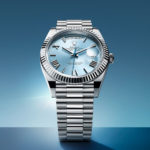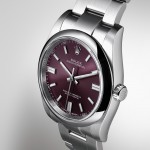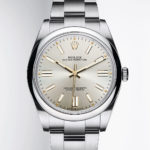In-Depth: A Dive Into the Oyster Perpetual Rolex Deepsea
The secrets to record-setting depths.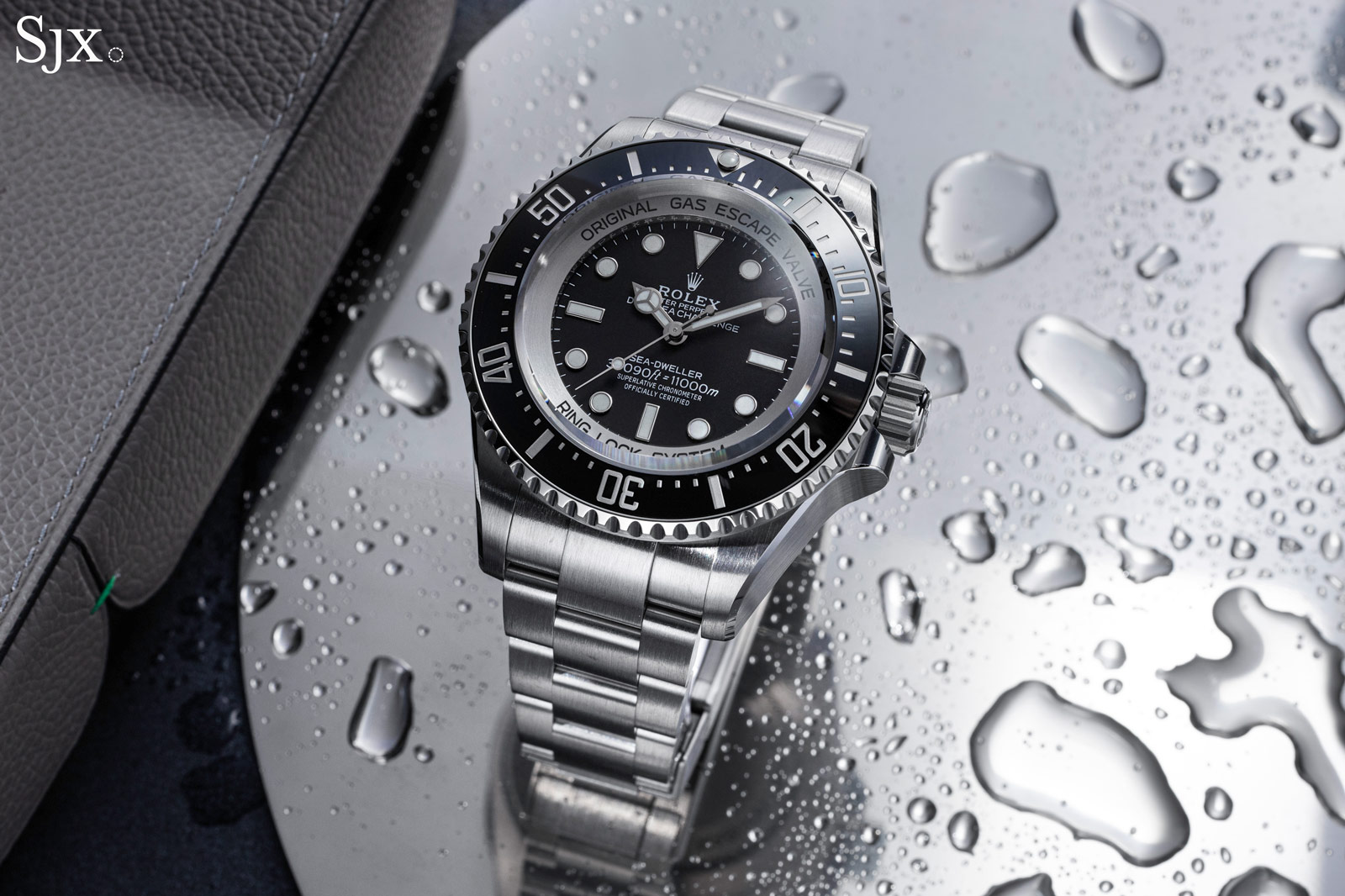
While the history of the Rolex diver’s watch begins with the Oyster Perpetual Submariner of 1953, one of the brand’s landmark achievement in water-resistant cases is more recent: the Oyster Perpetual Rolex Deepsea launched in 2008 that incorporates the Ringlock system.
With the innovative Ringlock system, Rolex surmounted an enduring obstacle in building a deeper-diving watch – a case that grew in proportion to the depth rating. The Ringlock system is a patented case architecture that fundamentally rethought the traditional approach to a diver’s watch, which allowed the Rolex Deepsea to achieve a water-resistance rating of 3,900 m with a 44 mm case.
The utility of the Ringlock was proven in 2022 with the Oyster Perpetual Deepsea Challenge that took the Oyster case to the limits of horological engineering. Featuring a 50 mm case in RLX titanium, the Deepsea Challenge is water resistant to 11,000 m – the all-time water-resistance record for a mechanical wristwatch.
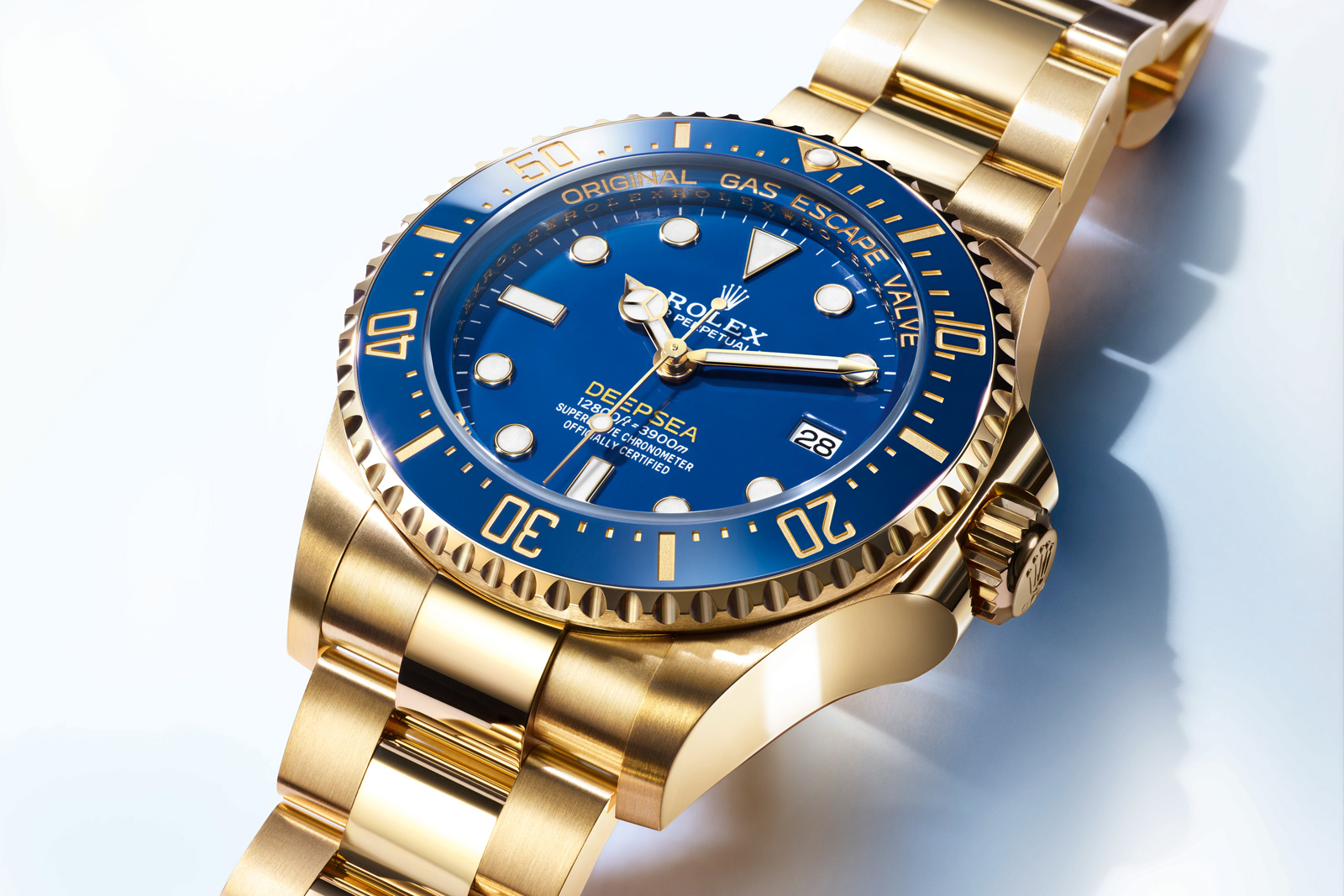
The latest addition to the deep-diving collection, the Oyster Perpetual Rolex Deepsea in 18k yellow gold. Image – Rolex
A deep history
The history of Rolex is inextricably intertwined with the water-resistant wristwatch. Six years after establishing the brand in 1908, Rolex founder Hans Wilsdorf wrote to Bienne-based movement maker Aegler, “We must find a way to create a waterproof wristwatch”. By 1926, Wilsdorf had achieved his goal with the launch of the Oyster, a waterproof wristwatch which had a bezel, case back, and crown that each screwed into the case to ensure water tightness.
Rolex continued to notch up achievements in water-resistant watches, including the Oyster Perpetual Submariner in 1953 and the Oyster Perpetual Sea-Dweller of 1967, both serial production watches available to the public. But the depths were truly reached in 1960 with an experimental watch, the Rolex Deep Sea Special.

An example of the Rolex Deep Sea Special. Image – Rolex
An example of the Rolex Deep Sea Special was mounted to the hull of the Trieste, a bathyscaphe that became the first manned vessel to reach the deepest point on Earth when it descended 10,916 m to the Mariana Trench on January 23, 1960 with Swiss oceanographer Jacques Piccard and U.S. Navy officer Don Walsh at the helm.
In the following decades Rolex continued to work with deep sea diving professionals and researchers, including French deep sea engineering outfit Compagnie Maritime d’Expertises (Comex) and the American government’s Tektite project.
But the next major advance in the deep-diving Oyster case was the Rolex Deepsea of 2008, the first to employ the Ringlock system. The conception of the model included a special hyperbaric chamber developed in conjunction with Comex that tests every specimen of the Rolex Deepsea to its rated depth of 3,900 m, but with an additional a safety margin of 25%, taking the pressure to the equivalent of 4,875 m.
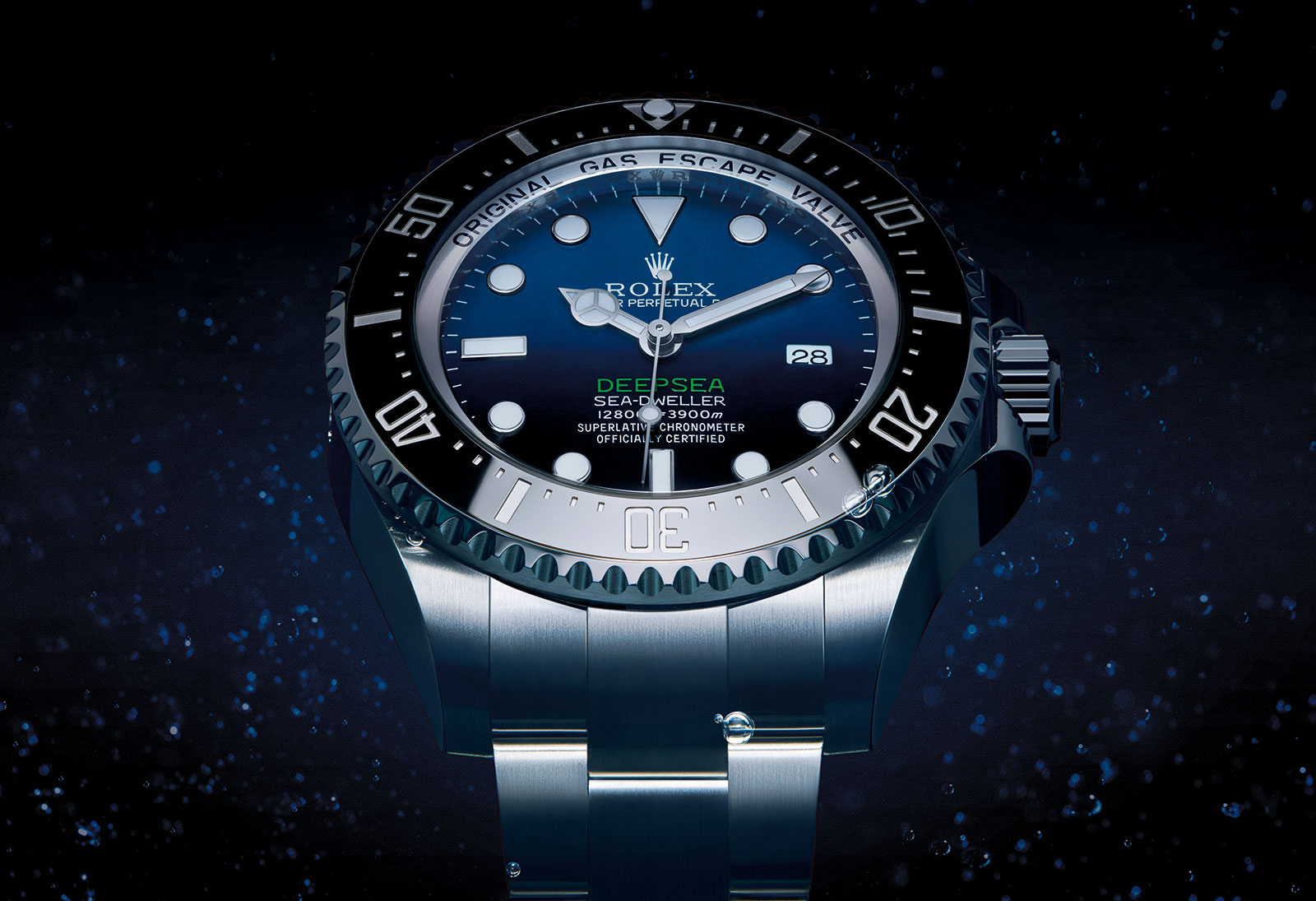
The Rolex Deepsea with a “D-Blue” dial. Image – Rolex
Four years later on March 26, 2012, Rolex returned with the Mariana Trench equipped with the Ringlock system. An experimental Deepsea Challenge watch was secured to the manipulator arm of the Deepsea Challenger, a submersible piloted by filmmaker and Rolex testimonee James Cameron, who piloted the craft solo to the depth of 10,908 m – though the watch was rated to 12,000 m.
Based on the record-setting experimental watch, the Rolex Deepsea Challenge made its debut in 2022 as the culmination of the brand’s expertise in dive watches.
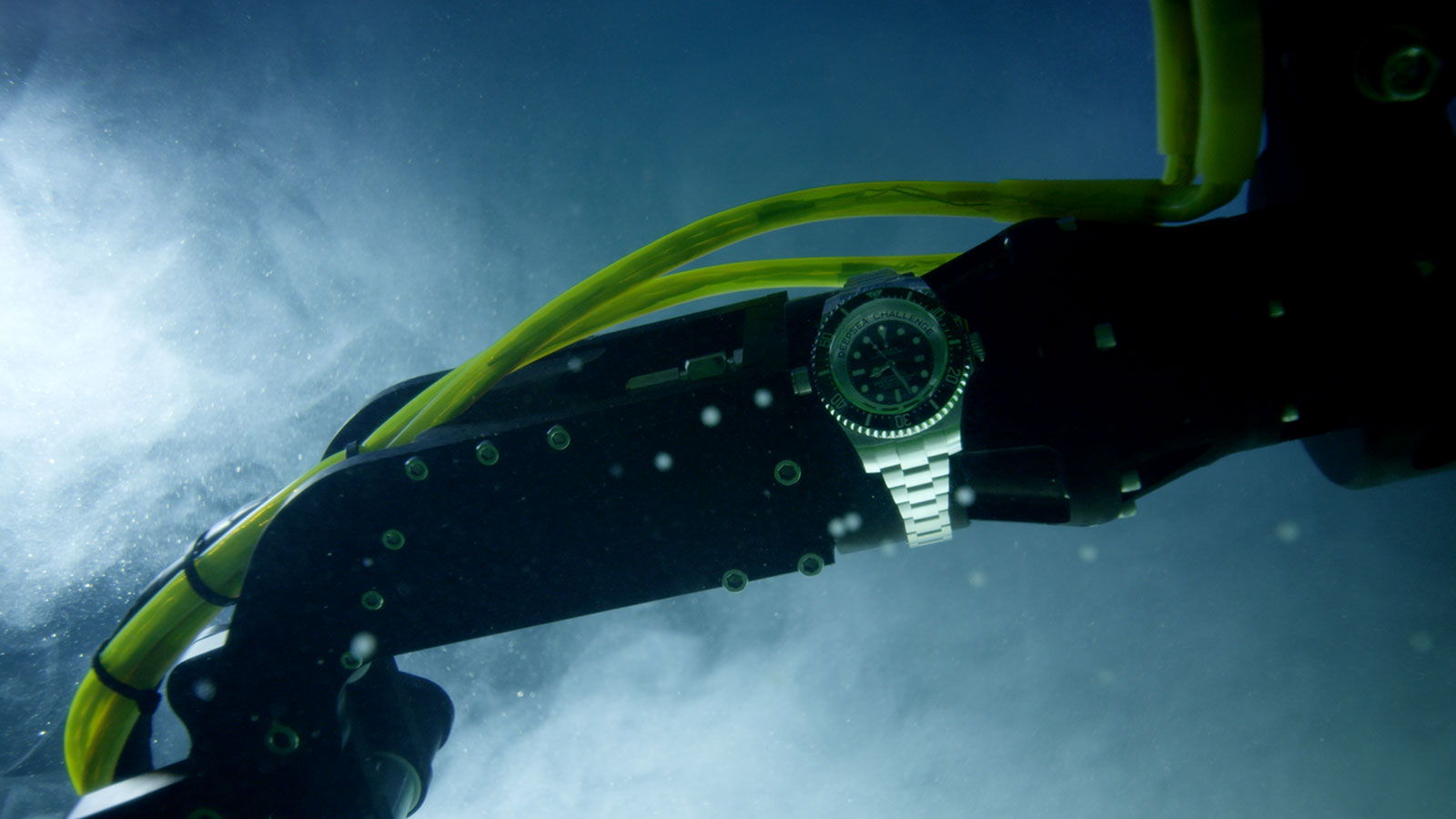
The Deepsea Challenge strapped to the arm of James Cameron’s submersible. Image – Rolex
The Ringlock
Both the Rolex Deepsea and Deepsea Challenge employ the same Ringlock system, but on a different scale, explaining the difference in case size and depth rating.
The Rolex Deepsea has a 44 mm case and 5.5 mm-thick crystal, along with a depth rating of 3,900 m. The Deepsea Challenge is 50 mm in diameter with a 9.5 mm crystal, and a depth rating of 11,000 m. Crucially, the Deepsea Challenge boasts more than double the depth rating of the Deepsea, but without a proportional increase in case size and volume, or crystal thickness.
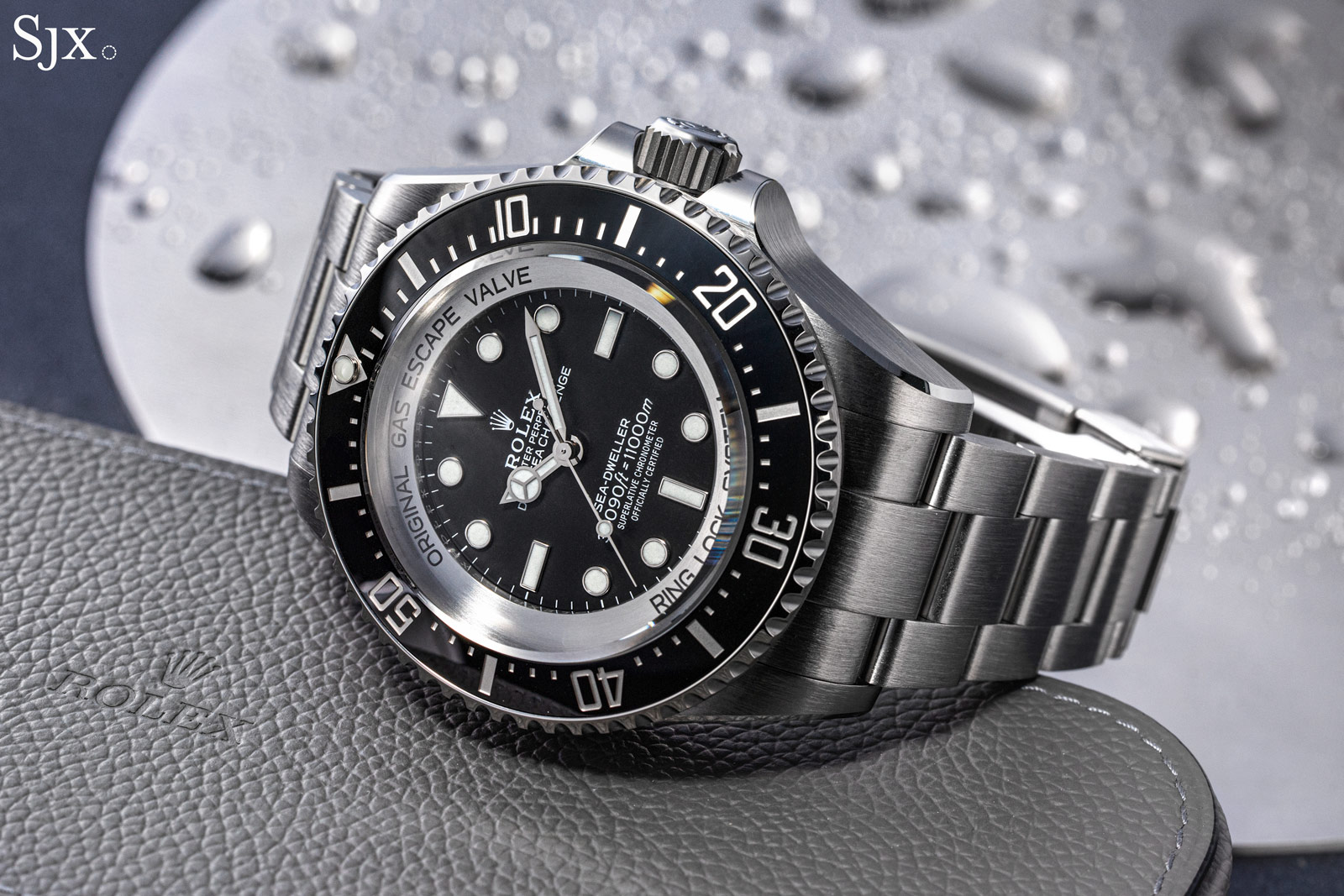
The Rolex Deepsea Challenge in RLX titanium
The secret to the Rolex Deepsea’s depth rating is the patented case architecture known as Ringlock, which essentially functions as an inner pressure-resistant case within the conventional Oyster case. On other words, the Oyster case of the Rolex Deepsea differs fundamentally from all the other Oyster cases.
On its face, Ringlock is a deceptively simple label that suggests some form of locking ring for the case. In fact, it is actually an intricate and ingenious internal architecture that maximises pressure resistance within the Oyster case.
The Ringlock system consists of three main elements: a domed sapphire crystal, a steel compression ring that doubles as the movement holder, and a RLX titanium case back. Together, the three elements of the Ringlock form a capsule containing the movement and dial that is separate from the outer Oyster case.
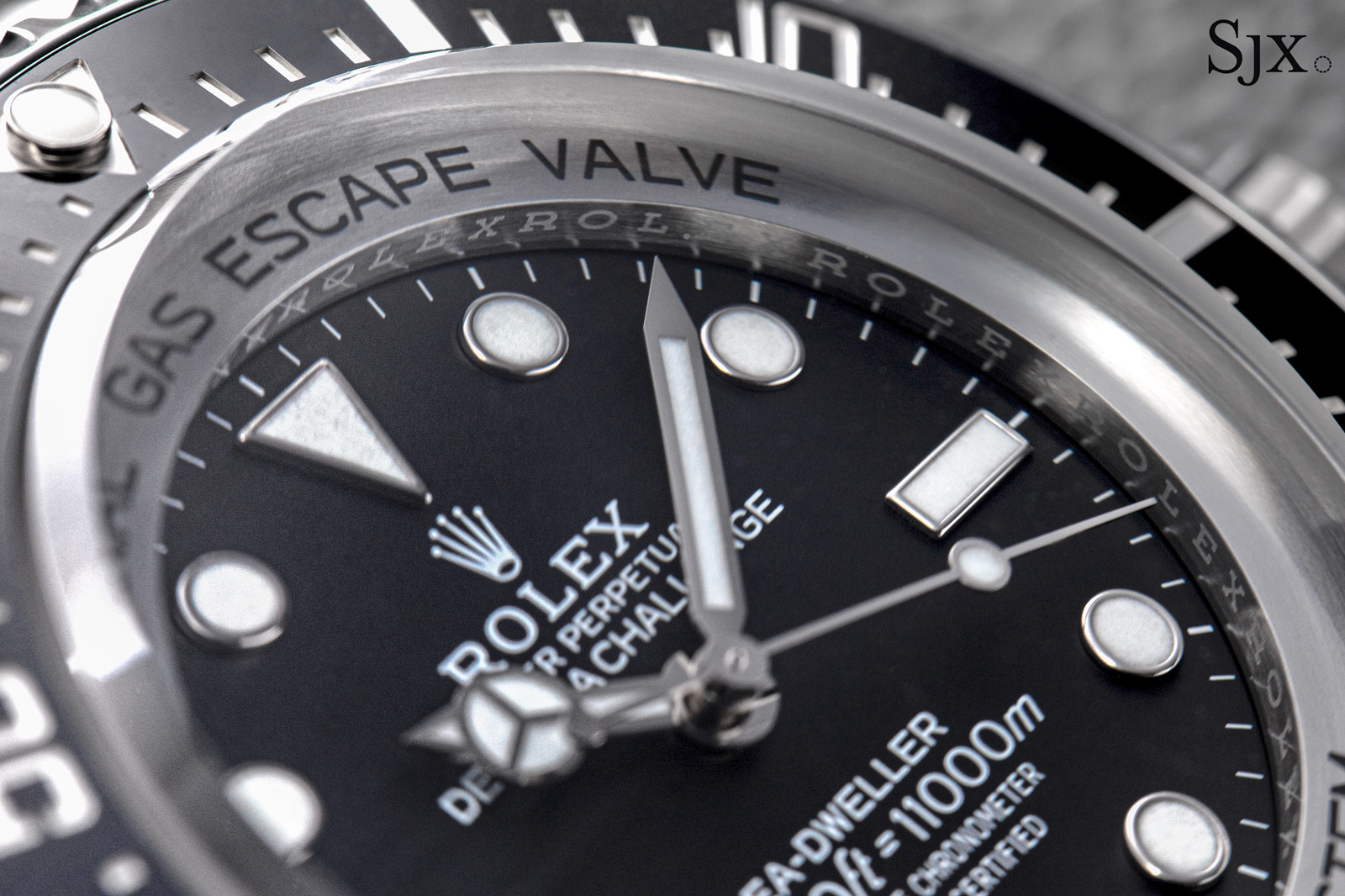
The movement ring of the Ringlock system forms a raised border around the dial
A perfect seal
In conventional dive watches that are typically pressure resistant to 200 m or 300 m, a plastic or polymer gasket secured by adhesive sits between the crystal and case, and the screw-down back also contains a gasket. This construction is a sandwich that has little vertical “give”, so when the watch be subjected to higher pressure than intended, the crystal is compressed downwards towards the case, eventually cracking the gasket or crystal.
The Ringlock system’s key innovation is the seal between the sapphire crystal, compression ring, and case back, which separates the resistance to compressive force from the sealing function. Instead of having the gasket between the glass and metal, the Ringlock system features a tubular sleeve gasket (Rolex describes it as a “crystal gasket”) that snugly encircles the middle ring and the sapphire. As a result, there is no gasket between the crystal and compression, allowing the two materials, namely sapphire and steel, to make direct contact.
The compressive forces exerted at great depth on the crystal and back are separate from the sleeve gasket that sits around the outside of the Ringlock system components, leaving the sleeve gasket unharmed by the pressure-induced compression.
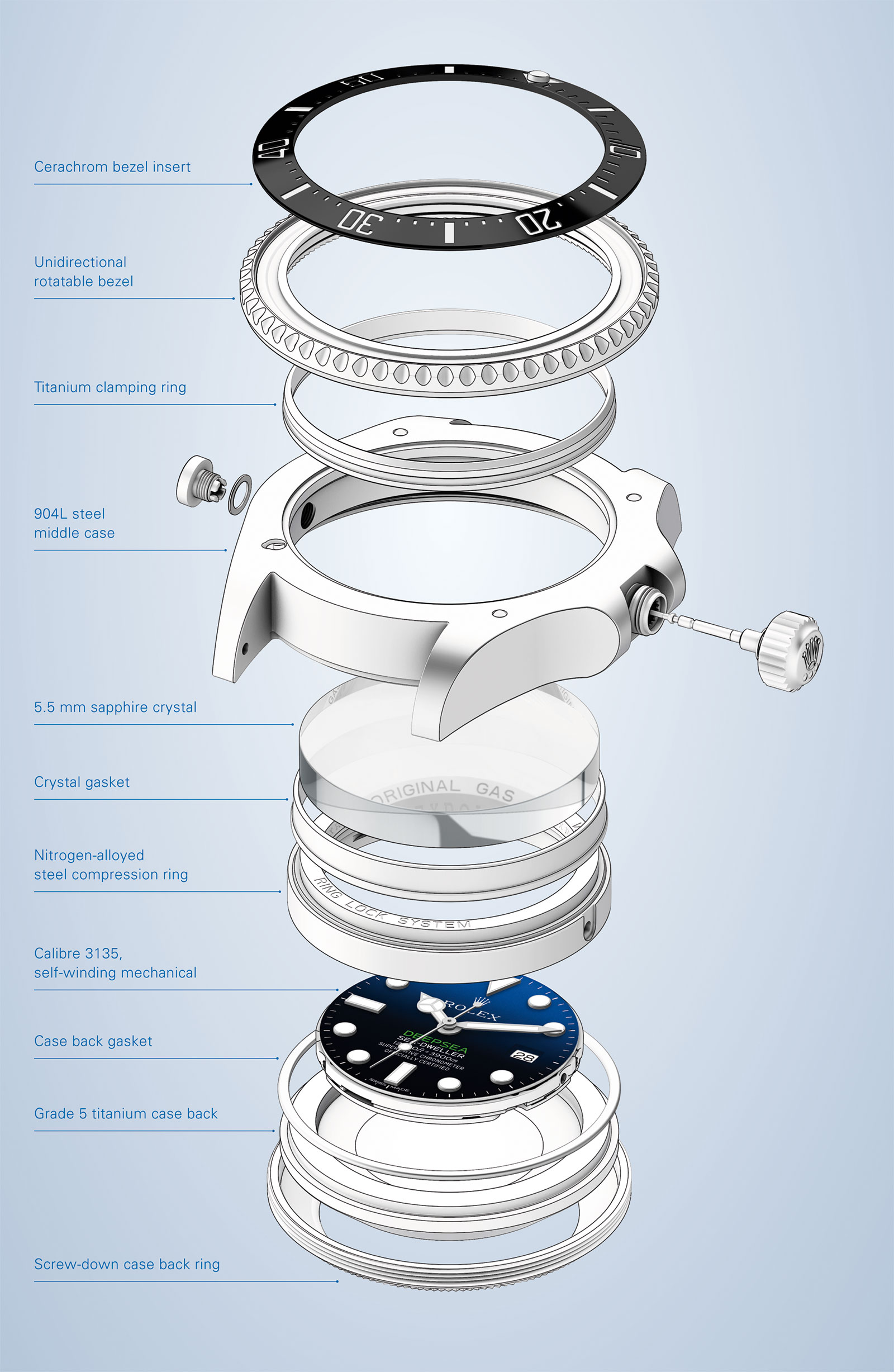
An exploded view of the Rolex Deepsea case construction. Image – Rolex
On the back, the compression ring similarly sits against a domed RLX titanium case back (that’s secured by an outer case back ring). This is possible because titanium is light, strong, and flexible. As a result, as pressure increases, the domed case back is compressed and flattened towards the compression ring, actually enhancing the seal as the depth increases.
On the front, sapphire has almost no flexibility, but the thickness of the crystal ensures it retains its structural integrity under pressure, which only serves to compress it against the compression ring, similarly enhancing the seal. In short, the Ringlock system relies on the compressive force of water at great depth to increase the case seal.
Ringlock construction
The unique construction of the Ringlock system relies on the properties of three separate materials for water-resistance at great depth: sapphire for the crystal, nitrogen-alloyed steel for the compression ring, and RLX titanium for the case back. (The compression ring is blue ceramic in Rolex Deepsea in 18k yellow gold for aesthetic purposes but serves the same function.)
Notably, the case back is actually two parts, an inner titanium case back sitting on the compression ring, that is secured in place by a screw-down case back ring that screws into the Oyster outer case.
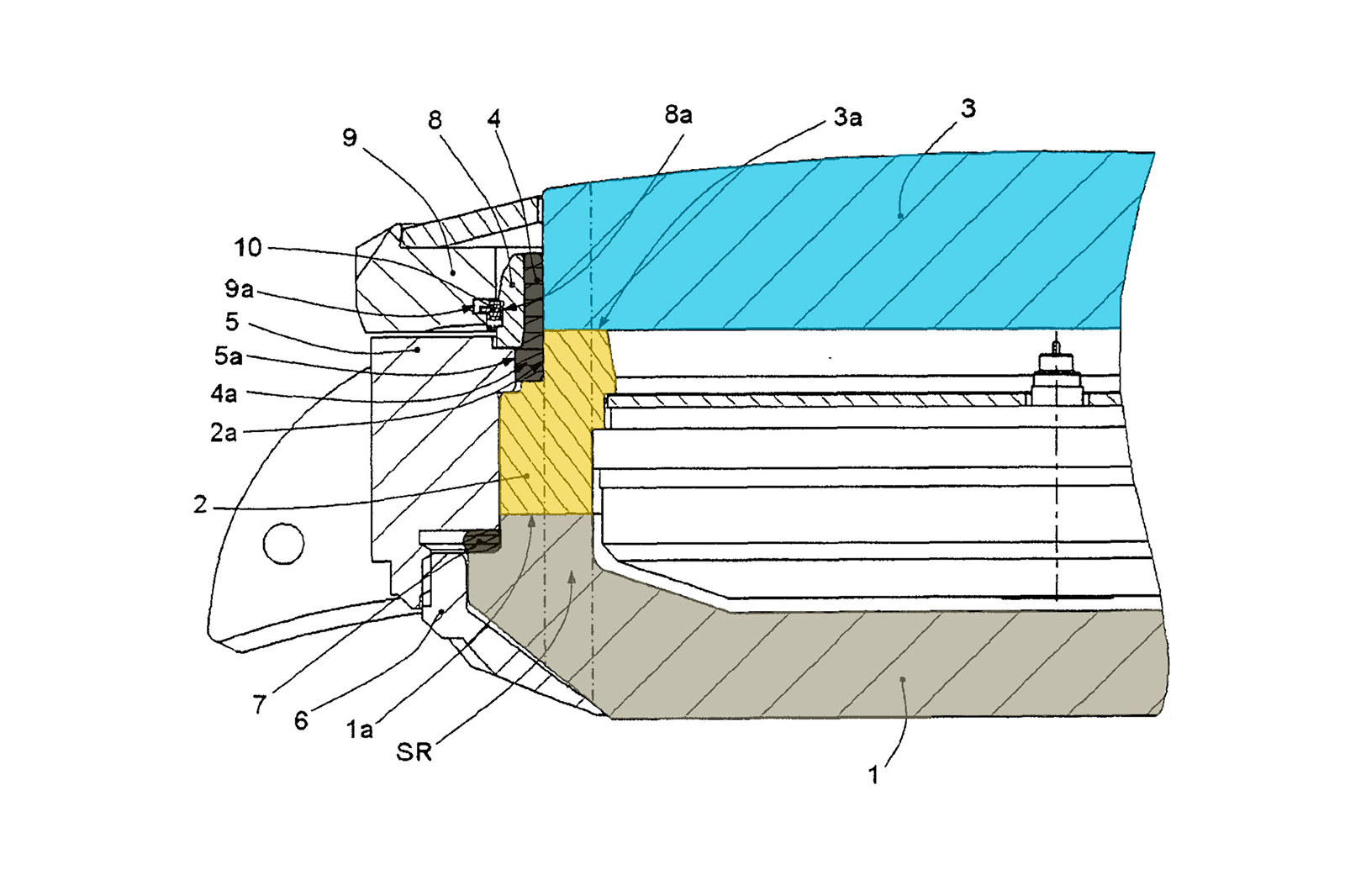
Figure 1: A cross section of the Ringlock system within the case. Image – patent EP1916576A1
Figure 1 illustrates the cross-sectional view of the Ringlock system. The thick sapphire crystal in blue (3) sits directly on the compression ring in yellow (2). The RLX titanium case back in grey (1) sits against the underside of the compression ring (3). Importantly, Figure 1 reveals all the three components are in direct contact with each other no gaskets between them.
The sleeve gasket in black (4) encircles around the compression ring (2) and crystal (3), bracing against them tightly and sealing the joint between the two. Another second gasket (7) creates a seal between the titanium case back (1) and the outer Oyster case. The RLX titanium case back is held in place tightly by the case back ring (6).
The outer Oyster case (5) does not actively aid in the pressure resistance, rather it serves as a container for the Ringlock system. The Ringlock system, in turn, is a pressure resistant capsule for the movement.
The innovative Ringlock system architecture is mostly concealed, except for one very visible portion: the raised, engraved ring around the dial is actually the top of compression ring (2) sitting directly under the crystal (3). In fact, the ring around the dial is surface (3a) in Figure 1. This visible section illustrates one of the key features of the Ringlock system, the wearer can see right through the periphery of the sapphire crystal into the compression ring that sports a concentric brushed finish.
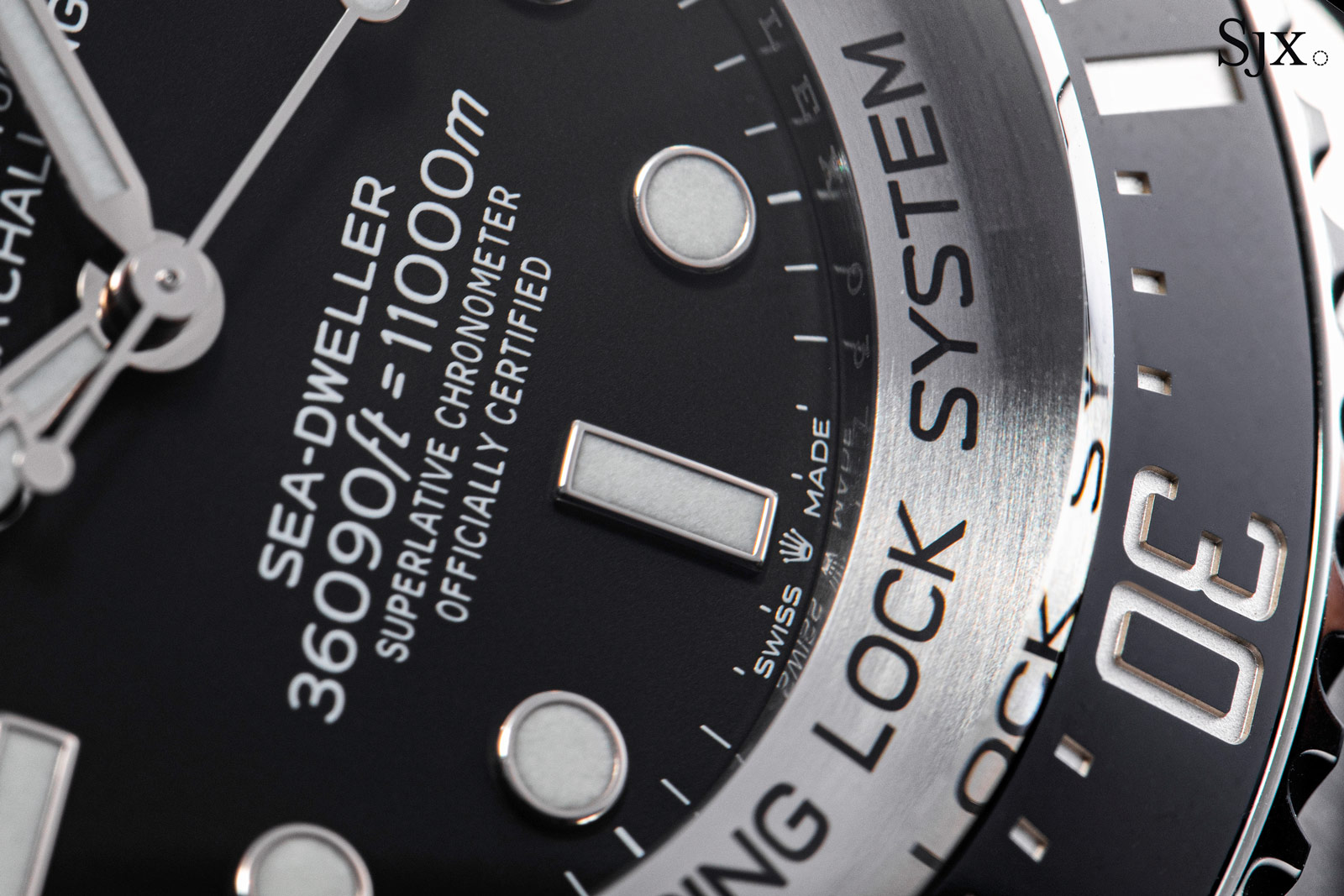
While the purpose of the Ringlock system is to ensure water resistance at depth, its key advantage is case size.
That might seem paradoxical given the Rolex Deepsea is a large, chunky watch – and the Deepsea Challenge even bigger – but the innovative construction results in a much slimmer case as compared to a similarly pressure-resistant case with a conventional mono-body construction. Put another way, a traditional Oyster case with the same depth rating as the Rolex Deepsea would be significantly thicker.
Table 1 compares the thickness of a Ringlock system-equipped case to a classic Oyster case with equivalent pressure resistance. The Ringlock construction is about 10% slimmer.
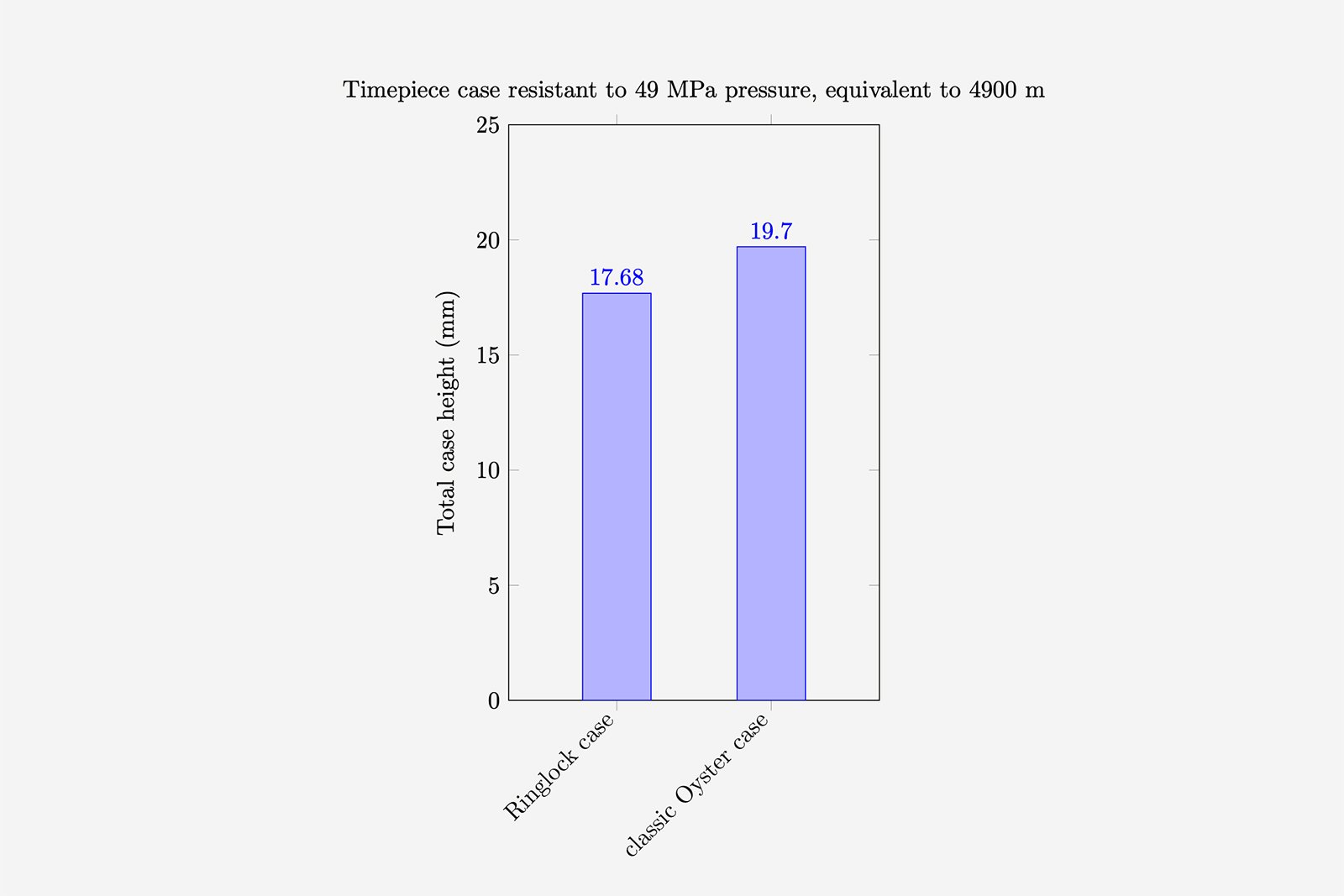
Table 1: Case thickness comparison. Data – patent EP1916576A1
Ringlock materials
The Ringlock system can also be described as a compound case that separates the various physical functions of a water-resistant case into various interlocking components, allowing the system to exploit specific materials for their respective physical properties.
Even though the external components of the Rolex Deepsea are traditional, including an Oyster case in Oystersteel, RLX titanium, or 18k yellow gold, as well as a dial sporting hands and hour markers in 18k gold, the Ringlock system relies on a more novel alloy.
The compression ring is a nitrogen-alloyed steel, specifically an alloy known as Biodur 108 according to the Ringlock system patent. According to its manufacturer, Biodur 108 boasts “greater tensile strength and resistance to fatigue” compared to steels commonly used in watchmaking like 316L.
Because of its relatively high nitrogen content, the steel alloy can better withstand compressive force without buckling, compared to conventional watchmaking steel. Additionally, the alloy is also corrosion resistant and non-magnetic, all useful properties for a watch component.
(The latest version of the Deepsea is in 18k yellow gold and replaces nitrogen-alloyed steel with ceramic for the compression ring. Ceramic has even greater strength than steel.)
Table 2 shows the compression limits of the various materials employed in a Rolex Deepsea case. Note the strength of the materials that make up the Ringlock system – sapphire, titanium, and nitrogen-alloyed steel – compared to that of Oystersteel and 18k gold.

Table 2: Compression strength of materials. Data – patent EP1916576A1
Triplock crown
While the Ringlock system is unique to the Rolex Deepsea family, the Rolex Deepsea cases also incorporates two Rolex inventions synonymous with its diver’s watches, including the patented Triplock crown. “Triplock” doesn’t merely imply triple gaskets in the crown, but rather refers to the three separate sealed zones, namely the crown cap, stem, and tube.
Despite being one of the smallest components of the case, the Triplock crown is a surprisingly complex assembly that even includes a clutch to uncouples the crown cap from the stem when it is screwed and unscrewed.
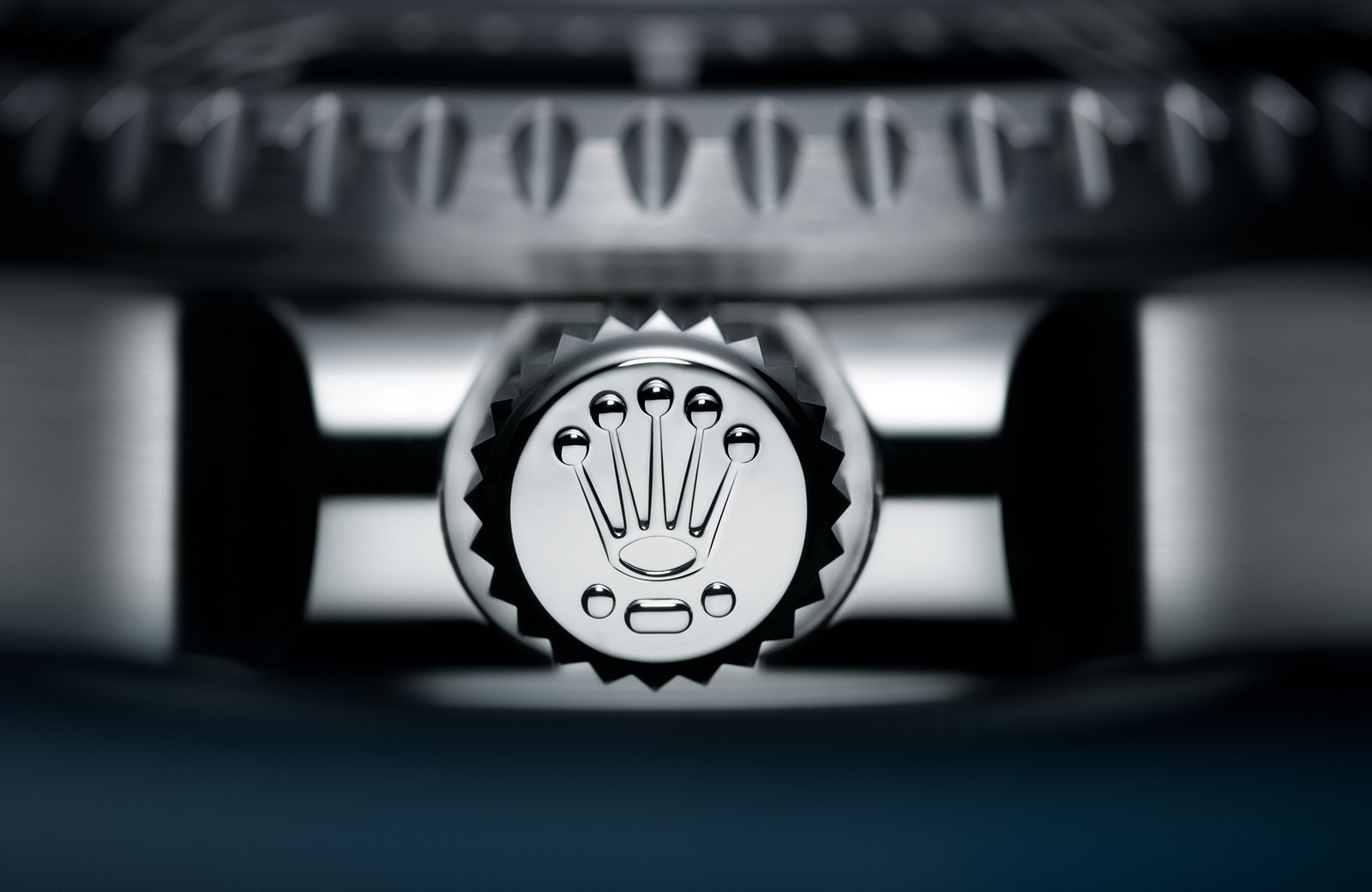
The signature “dot-dash-dot” emblem of the Triplock crown on the Deepsea Challenge. Image – Rolex
Furthermore, the Triplock system comprises two types of gaskets. One is passive gaskets to assure a certain degree of water and dust protection when the crown is unscrewed.
Active gaskets, on the other hand, are compressed together when the crown is screwed down. One active gasket is compressed between the crown cap and top of the tube when the crown is screwed down, and another set of active gaskets compress and seal the stem against the inside of the tube.
The crown tube itself is screwed into the outer Oyster case and protected by its own set of gaskets. Once screwed down onto the tube, the crown is mostly unaffected by ambient pressure because of its size and shape, ensuring the compressive gaskets are safe and remain water resistant at any rated depth.
Helium escape valve
Like the Oyster Perpetual Sea-Dweller before it, the Oyster case of the Rolex Deepsea incorporates an automatic helium escape valve at the nine o’clock position on the case flank. Compared to the manually-operated helium valves found on some dive watches, its valve is self-actuating and releases trapped gases without the need for user activation.
A helium escape valve is useful in a rare and specific situation – saturation diving that takes place at great depths. The record for an offshore saturation dive was achieved in 1988 during the Hydra VIII expedition when six divers, four from Comex and two from the French navy – all wearing Sea-Dweller watches – performed work at 520 m off the coast of Marseille.
And in 1992, Comex staged Hydra X, an experiment that saw diver Theo Mavrostomos reach a simulated depth of 701 m in a hyperbaric chamber, a feat that took him 43 days and established a record that has yet to be broken.
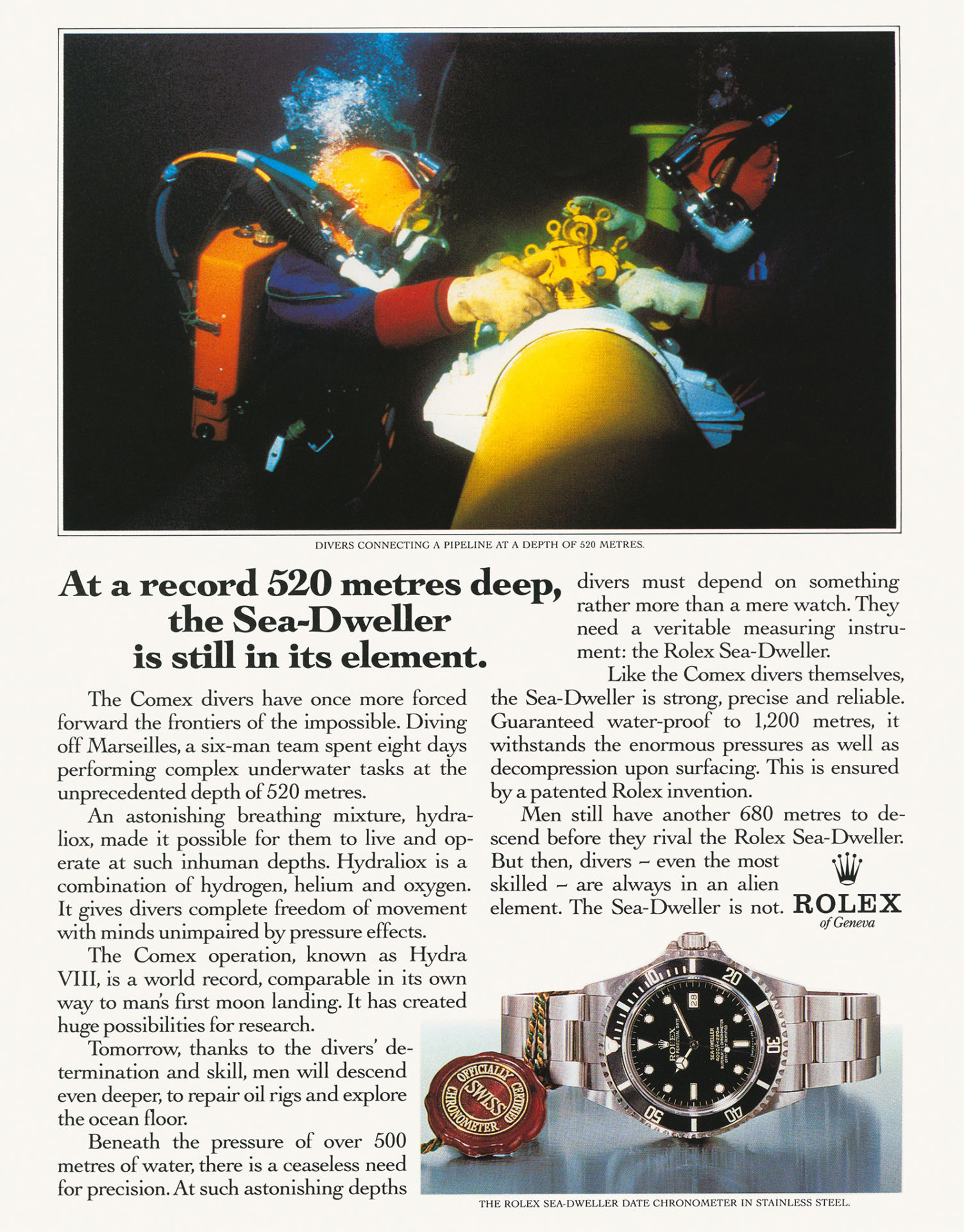
Period Rolex advertising detailing the Hydra VIII operation. Image – Rolex
The lengthy process of saturation diving is the result of the time divers spend in hyperbaric chambers before and after the dive.
Prior to submerging, divers have to inhale a special, helium-rich gas mixture that increases internal body pressure to match that of the deep sea environment. And when they surface, divers have to do the reverse in a decompression process that reduces the internal body pressure by gradually eliminates the helium from their bodies.
It is during this process that helium can enter a watch. Because helium atoms are amongst the tiniest, they can penetrate the various gaskets and seals of a watch case, but they are not removed from the watch case during decompression.
As a result, helium trapped inside a watch expand and then exit the case at an accelerated rate, which can cause the crystal to pop off. To prevent exploding crystals, the helium escape value was invented. It allows trapped gas to safely escape the case via a dedicated valve automatically opens as pressure builds up within the case during decompression.
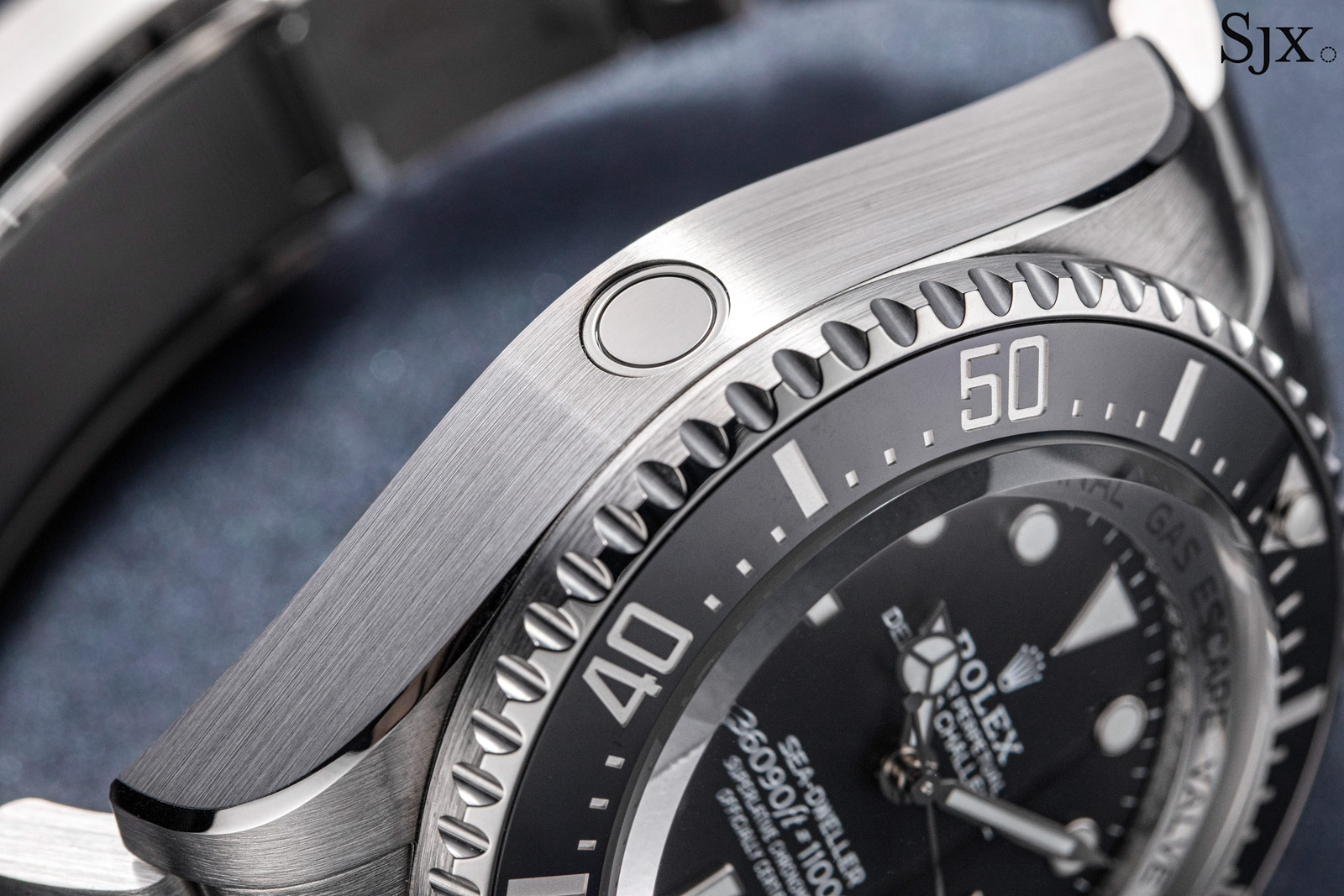
The helium escape valve on the Rolex Deepsea Challenge
The first Rolex patent for a helium escape valve was granted in 1967 and consists of a simple construction (Figure 2). The helium escape valve in the Rolex Deepsea works on the same principle, although its execution has refined over the years.
At most times, the valve is kept shut against the case by a tensioner spring. When helium builds up inside the case, creating enough pressure, the spring releases and a plunger-like tube rises outwards from the case, allowing the gas to escape, creating equilibrium between the pressure inside and outside the case. When the interior pressure is equalised, the plunger returns back into the case and the valve snaps shut.
When closed, the top of the plunger sits in a recess on the case side and presses against a series of gaskets, ensuring a watertight seal.
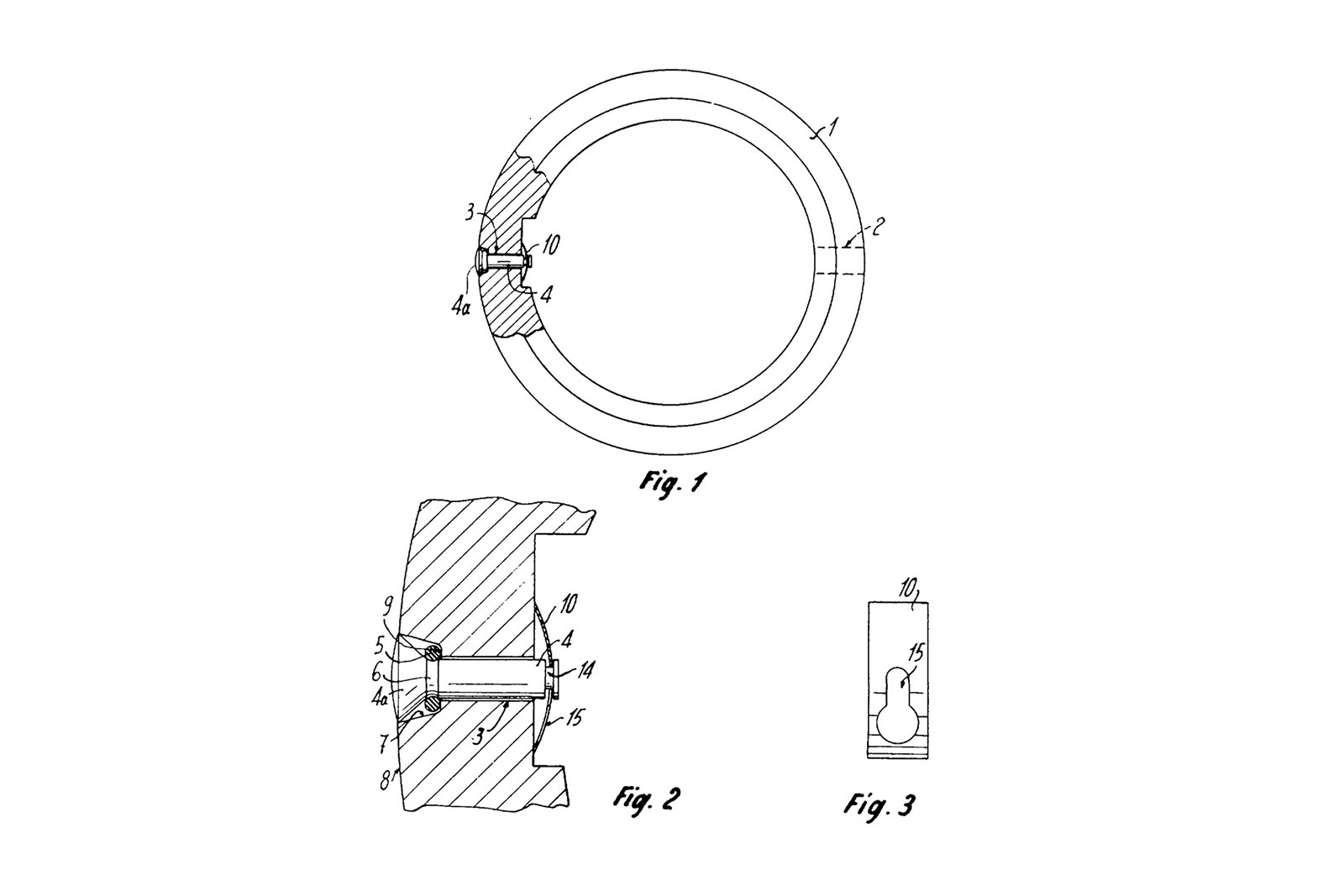
Figure 2. The early helium escape valve. Source – Patent CH492246A
It is important to note that decompression happens in a dry environment, so there is no water infiltrating the case when the valve opens. But that also raises the question of what happens to the valve at great depths since a pressure resistant case should ideally have a solid case with as few openings as possible.
A well-constructed helium escape valve, however, seals itself in a manner similar to the Ringlock system. When submerged to great depths, the pressure of the surrounding water pushes against valve against the case, strengthening the seal between the valve and case.
This was brought to you in partnership with The Hour Glass. For more, visit Thehourglass.com.
Back to top.



